

Neuroscientists Successfully Demonstrate Rat and Monkey ‘Brainets’ A team of neuroscientists at Duke University published two separate studies today, one involving rats and the other involving rhesus macaque monkeys, that describe experiments on networks of brains, or Brainets, and illustrate how such networks could be used to combine electrical outputs from the neurons of multiple animals to perform tasks.
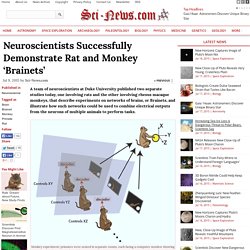
Monkey experiment: primates were seated in separate rooms, each facing a computer monitor showing the virtual avatar arm from a first person perspective. Image credit: Arjun Ramakrishnan et al. In the monkey experiment, Dr Miguel Nicolelis of the Duke University School of Medicine and his colleagues linked the brains of rhesus macaque monkeys, who worked together to control the movements of the arm of a virtual avatar on a digital display in front of them. Each animal controlled two of three dimensions of movement for the same arm as they guided it together to touch a moving target.
Arjun Ramakrishnan et al. 2015. Miguel Pais-Vieira et al. 2015. History of Neuroscience. Origins of Neuroscience - Stanley Finger - Oxford University Press. History. Society for Neuroscience. The History of Neuroscience reveals the field's evolution to present day.
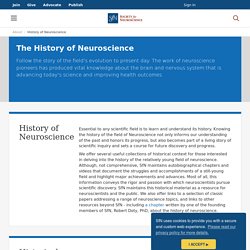
The work of neuroscience pioneers has produced vital knowledge about the brain and nervous system that is advancing today’s science and improving health outcomes. As with any scientific endeavor, more knowledge has produced new mysteries. The Most Important Brain in the History of Neuroscience. This post is in partnership with Publisher’s Lunch.

Hist_Neurosci_Ency_neurosci.pdf. History of neuroscience: Ramon y Cajal — Neuroscientifically Challenged. Although many consider him now to be the "father of modern neuroscience," when Santiago Ramon y Cajal (1852-1934) was a boy he dreamed of one day being an artist.
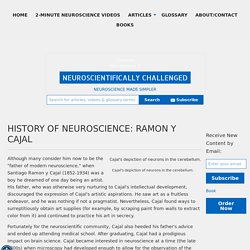
His father, who was otherwise very nurturing to Cajal's intellectual development, discouraged the expression of Cajal's artistic aspirations. History of neuroscience: Fritsch and Hitzig and the motor cortex — Neuroscientifically Challenged. José Delgado's "Physical Control of the Mind" A Brief Biography of the Cortical Column. Introduction – The Cortical Column “Problem” In a theoretical paper, H.
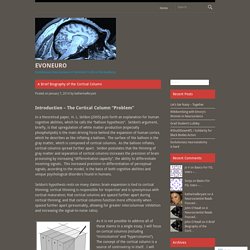
L. Virtual Electrophysiology with SPatch — Brains, Minds & Media. Virtual Electrophysiology with SPatch Applications in undergraduate education Robert C Cannona* and Constance Hammondb a Textensor Limited, 37 McDonald Road, Edinburgh, United Kingdom b Institut de Neurobiologie de la Méditerranée, 163 route de Luminy, BP13, 13273 Marseille Cedex 09, France *Corresponding Author: Robert Cannon, Address: as above, Phone and Fax: +44 131 466 8356, email: robert.c.cannon@gmail.com Abstract.
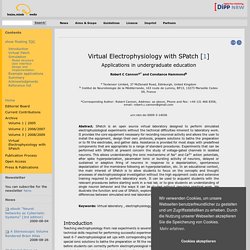
World's first brain prosthesis revealed - 12 March 2003. The world's first brain prosthesis - an artificial hippocampus - is about to be tested in California.
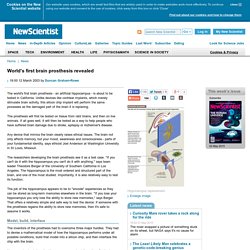
Unlike devices like cochlear implants, which merely stimulate brain activity, this silicon chip implant will perform the same processes as the damaged part of the brain it is replacing. The prosthesis will first be tested on tissue from rats' brains, and then on live animals. If all goes well, it will then be tested as a way to help people who have suffered brain damage due to stroke, epilepsy or Alzheimer's disease.
Any device that mimics the brain clearly raises ethical issues. Access : The Forgotten Era of Brain Chips : Scientific American. DARPA Program Seeks to Use Brain Implants to Control Mental Illness. Researcher Jose Carmena has worked for years training macaque monkeys to move computer cursors and robotic limbs with their minds.

He does so by implanting electrodes into their brains to monitor neural activity. Untitled. Eye, Brain, and Vision. Sebastian Seung’s Quest to Map the Human Brain. Photo.

Trapped In His Body For 12 Years, A Man Breaks Free. Martin Pistorius sometime between 1990 and 1994, when he was unable to communicate.

Courtesy of Martin Pistorius hide caption itoggle caption Courtesy of Martin Pistorius. Brain-Mapping Pioneers. Brain-Mapping Pioneers What would you do if you were a doctor and had patients who were missing pieces of their skulls? If you were Eduard Hitzig, a German doctor working at a military hospital in the 1860s, you'd conduct some experiments. Hitzig, working on patients who had pieces of their skulls blown away in battle, stimulated exposed brains with wires connected to a battery. By doing so, he discovered that weak electric shocks, when applied to areas at the back of the brain, caused the patients' eyes to move. Alexander Luria: life, research & contribution to neuroscience.
Brain decoding: Reading minds. Jack Gallant perches on the edge of a swivel chair in his lab at the University of California, Berkeley, fixated on the screen of a computer that is trying to decode someone's thoughts. On the left-hand side of the screen is a reel of film clips that Gallant showed to a study participant during a brain scan. And on the right side of the screen, the computer program uses only the details of that scan to guess what the participant was watching at the time. Anne Hathaway's face appears in a clip from the film Bride Wars, engaged in heated conversation with Kate Hudson. The algorithm confidently labels them with the words 'woman' and 'talk', in large type. Another clip appears — an underwater scene from a wildlife documentary.
“This is a manatee, but it doesn't know what that is,” says Gallant, talking about the program as one might a recalcitrant student. Listen Neuroscientists can predict what a person is seeing or dreaming by looking at their brain activity. Beyond blobology. Theories. Theories of Colour Vision Theories of Colour Vision There are two major theories that explain and guide research on colour vision: the trichromatic theory also known as the Young-Helmholtz theory, and the opponent-process theory. These two theories are complementary and explain processes that operate at different levels of the visual system. Trichromatic Theory. 2003 Hebbian LTP - Memory. The Hebb Legacy. The Hebb Legacy RAYMOND M. KLEIN, Dalhousie University Donald Olding Hebb (1904-1985) was, during his lifetime, an extraordinarily influential figure for the discipline of psychology.
His principled opposition to radical behaviourism and emphasis on understanding what goes on between stimulus and response (perception, learning, thinking) helped clear the way for the cognitive revolution. His view of psychology as a biological science and his neuropsychological cell-assembly proposal rejuvenated interest in physiological psychology. Since his death, Hebb’s seminal ideas exert an ever-growing influence on those interested in mind (cognitive science), brain (neuroscience), and how brains implement mind (cognitive neuroscience).